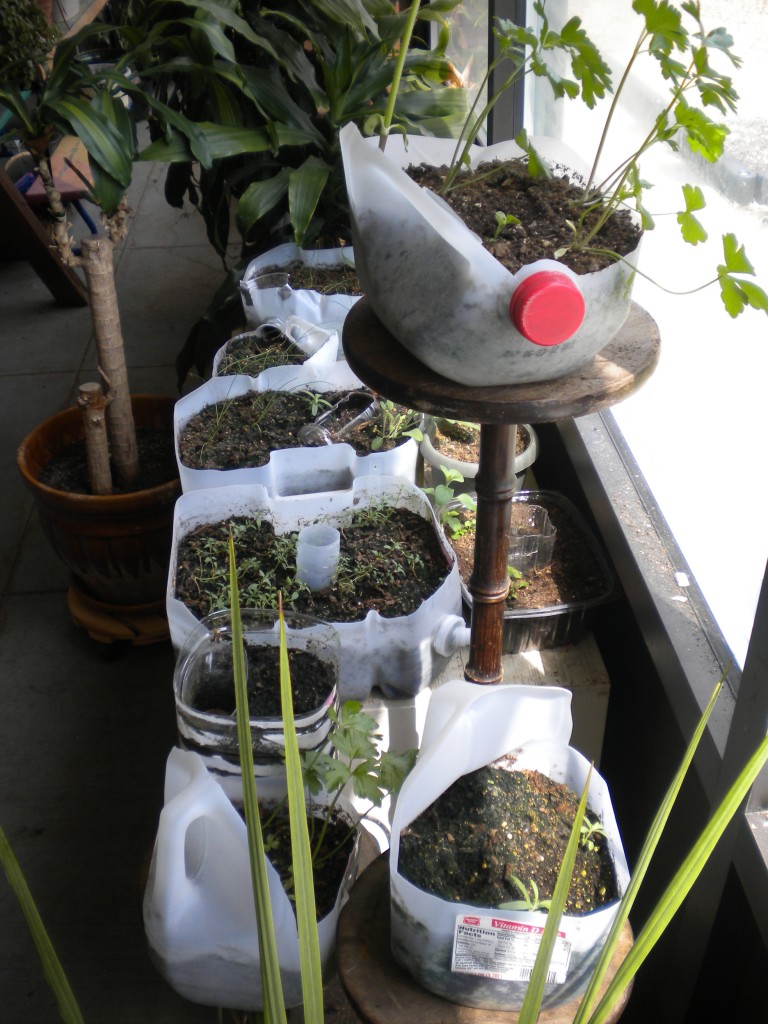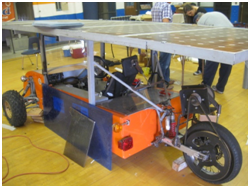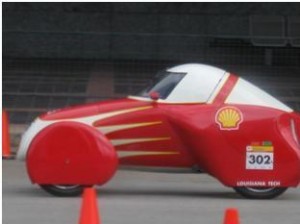Evan Johnson, an Energy Corps member serving with Opportunity Link, is growing things in Havre.
Flower pots are expensive. Even the cheap ones cost money that could otherwise pay for seeds, soil, or groceries. But in the “Garden Room” at the District IV HRDC building in Havre, MT, some alternatives are proving themselves worthy of attention. Coffee tubs, milk jugs, and more serve as homes for plants. Many of these plants are kept by a woman I’ve never met. The extent of her indoor plantings is such that she has a monopoly on the empty tubs of cheap ground coffee from the building’s break room. An AmeriCorps VISTA and I have added the milk jug planters with lavender, sage, rosemary, and other herbs. Unlike the experienced gardener’s consistent use of coffee tubs in the standard potted plant style, our milk jugs come in several different varieties. Next to them are larger water jugs, also unique semi-experimental designs. Most of our planters are based on the principle of watering from below. Soil sits atop gravel, and there is a way to pour water directly into the gravel layer.
MSU Extension promotes a bucket-based variant using plastic tubing for watering. A number of other designs are available on the internet. This style of planter is extremely easy to build using only materials scavenged from the trash. A wide variety of materials can work well, so this is a nice small-scale supplement to the limited recycling programs available in Havre. The basic recipe goes like this:
 1) Find a water-tight container large enough to accommodate at least one plant.
1) Find a water-tight container large enough to accommodate at least one plant.
2) Set it down in a stable position and cut off the side facing the ceiling.
3) Optional: Poke a hole near the top of the gravel layer to drain excess water.
4) Fill the bottom 1/5 of the container (or 1 inch, whichever is greater) of gravel, glass cullet, broken pottery, or other non-toxic gravel-like material.
5) Find a much narrower container such as a bottle and cut it so its top and bottom are both open.
6) Optional: Cut that bottle in half lengthwise if you want to pour water down the side of the container rather than in the middle.
7) Position your new improvised funnel and fill in the large container with soil.
8) Plant something and pour some water in through you improvised funnel.
Any water-tight container will do as long as it isn’t contaminated with anything that could harm your plants. The MSU Extension office here in Hill County has even made large planters out of plastic storage bins.
This is just one example of of re-use in Havre. Members of the community have also built raised beds out of broken shipping pallets (including some for the small community garden we’re starting here at the HRDC building), re-used glass bottles to store home-made beverages, and even used unwanted hubcaps to build a shiny metal tree. Here at Opportunity Link and the HRDC building we hope to expand our re-use of waste materials to include homemade cages for tomato plants and a compost pile for the whole garden.
 Evan Johnson is assisting Opportunity Link with environmental education and outreach programs to promote sustainable practices in North-Central Montana. A recent graduate of Carleton College with a BA in Geology, Evan thoroughly enjoys outdoor recreation, particularly running and rock climbing. He attended the Indiana University Geological Field Camp near Cardwell, MT and participated in several volunteer trips with Habitat for Humanity, helping build homes in places ranging from Hawaii to Kyrgyzstan.
Evan Johnson is assisting Opportunity Link with environmental education and outreach programs to promote sustainable practices in North-Central Montana. A recent graduate of Carleton College with a BA in Geology, Evan thoroughly enjoys outdoor recreation, particularly running and rock climbing. He attended the Indiana University Geological Field Camp near Cardwell, MT and participated in several volunteer trips with Habitat for Humanity, helping build homes in places ranging from Hawaii to Kyrgyzstan.








